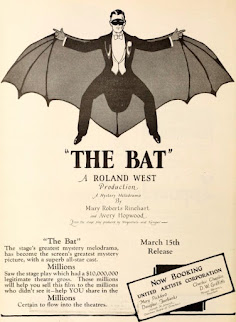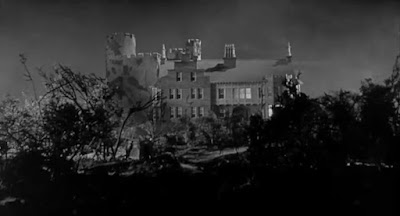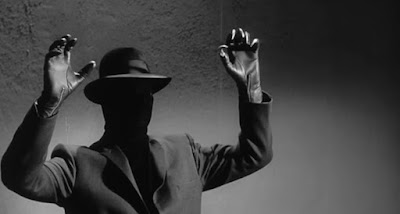... aka: Das Biest (The Beast)
... aka: Garras del murciélago (Bat Claws)
... aka: Il mostro che uccide (The Monster That Kills)
... aka: Le masque (The Mask)
... aka: Ölüm Saçan Yarasa (The Deadly Bat)
... aka: Vampyren (The Vampire)
... aka: Yön pahat silmät (Evil Eyes of the Night)
Directed by:
Crane Wilbur
Mary Roberts Rinehart's The Circular Staircase was first published in six parts in All-Star Weekly magazine in 1907, with a novelization following in 1908. The book was popular, so a (now-missing) silent film adaptation was made by Edward LeSaint in 1915. Though the film received middling to poor reviews, Rinehart decided to expand her property by purchasing back the rights and adapting it into a three act stage play. Utilizing the services of co-writer Avery Hopwood, alterations were made to the book's plot and it was re-titled The Bat; taking its namesake from a newly-added villain created specifically for the play. Rinehart and her husband themselves personally financed the play, which ended up paying off when it debuted in 1920 and became a huge hit with both critics and audiences alike. In America, it ended its initial run as the second longest-running play in Broadway history. There were road company productions that traveled the U.S. and it even made it overseas to London, where it was also a success. When all was said and done, the play was estimated to have grossed (according to an ad seen below) around 10 million dollars.
Due to its popularity, it's no surprise then that there were numerous film versions. The first, The Bat, came in 1926 from director Roland West, which was a box office success and praised by critics of the day. Just four years later, West remade the film again under the title The Bat Whispers (1930). This version was extremely innovative for its time, not only for being one of the first talkies but also for its widescreen photography (not at all common back then) and use of multiple cameras, crane shots and dollies for fluidity. Technical influence aside, it also made an indelible impact on pop culture when Bob Kane took inspiration from it for a comic book character he was creating. You've probably heard of him before: Batman.
There wouldn't be another filmed adaptation until 1956 (not long after a 1953 revival of the play), this time for the CBS TV series Climax! Directed by Ralph Nelson (who'd go on to direct Sidney Poitier in the Oscar-winning Lilies of the Field in 1964 and later made EMBRYO with Rock Hudson) and starring starred Judith Anderson, Kathleen Crowley and a young Kevin McCarthy, this episode is currently m.i.a. and is likely gone forever, though it leads us right up this fourth official version of The Bat. The following year, the story was back on TV as part of The Dow Hour of Great Mysteries; this time starring Helen Hayes and Margaret "Wicked Witch of the West" Hamilton. Finally, it became the basis of the German TV movie Der Spinnenmörder / "The Spider Killer" (1978), which was incidentally that last credited adaptation of any of Rinehart's work.
Famous murder-mystery novelist Cornelia van Gorder (Agnes Moorehead) rents a huge, remote mansion called The Oaks for an entire summer so she can get some work done. The place is spooky enough to provide the perfect ambiance for a horror writer just the way it is... and that's not even factoring in the home's sordid recent history! Just a few months earlier, a serial killer called "The Bat" murdered some people there and then vanished. And he / she / it / whoever is still out there. While that doesn't deter Cornelia, it does freak out her staff. Local gossip about recent "Bat" sighting have driven the butler, cook, maids and nearly everyone else away. Well, everyone except for Cordelia's faithful assistant of twenty years, Lizzie Allen (Lenita Lane, the director's wife). Cornelia and Lizzie are tight. Very tight. So tight that this 1959 film has been known to raise a few eyebrows, but we'll take a deeper dive into that here in a bit.
While The Oaks is the ancestral home of bank president John Fleming (Harvey Stephens), who vowed never to lease the property ever again after the last batch of murders, Cornelia actually rented it from his nephew, Mark (John Bryant), who seems to be trying to take advantage of the fact that his uncle is vacationing deep in the woods with his physician friend, Dr. Malcolm Wells (Vincent Price). With the two men at a cabin with no phone, so far away it takes "a 20 mile canoe trip" to make it back to civilization and not slated to be back until the end of the summer, it figures there's a huge emergency at the bank in their absence...
Bank vice president Victor Bailey (Mike Steele) discovers that 350,000 dollars of bonds, plus other negotiable securities, totaling over a million dollars, have been swiped from the vault. Seeing how only he and Fleming have access, suspicion soon falls on him. However, the real culprit is Mr. Fleming, who's stolen the money and stashed it in a hidden room at The Oaks. His vacation has been an excuse to fake his own death and he's hoping his buddy Malcolm will help in exchange for half a million dollars. Instead, Malcolm decides to kill him and blame a (hilariously convenient!) forest fire that breaks out right in the middle of their conversation. Now he'll have dibs on all the money... granted he can find it.
Back at The Oaks, Cornelia and Lizzie are terrorized by The Bat, a "faceless" black-clad, fedora-wearing figure with a razor-sharp steel claw glove (sounds quite similar to a pretty popular 80s slasher movie figure we all know!) that he's already used to rip out several throats. When the two women barricade themselves inside a bedroom, he unleashes a live bat into the room while they sleep, which bites Lizzie. Dr. Wells, now back in town after John's "accidental" death, comes to the mansion to treat Lizzie and encourages the two women to leave while he's there. The best case scenario for him is to obviously get the women out of the house so he can try to locate that hidden room John told him about.
Meanwhile, Lt. Andy Anderson (Gavin Gordon) is busy at working investigating matters. He spies on Dr. Wells and not only catches sight of him experimenting on live bats but also discovers a giant bat replica hidden behind a curtain in his lab. He goes to question nephew Mark, who's recently done a whole renovation on his real estate office. Just where did he get the money to do that? This case isn't just work for Andy, but also personal. He's on the bank's board of directors and had his life savings invested in bank stock, so if the money doesn't turn up, he'll probably never get to retire.
Despite everything that's been going on, Cornelia is able to convince her chauffeur, Warner (John Sutton), to work double duty as butler, and finds another apparently desperate woman named Jane Patterson (Riza Royce) to fulfill maid duties, so she can have a few guests over for the weekend. The first is Dale Bailey (gorgeous Elaine Edwards), Vic's wife, who's out to prove her husband's innocence. The other is Judy Hollander (Darla Hood, of Little Rascals fame), a bank secretary who claims she has information that will implicate John and is set to testify in court to that effect. Why anyone thought it was a good idea to have a key witness stay in a house being stalked by a killer is anyone's guess. It's an even worse idea to continue to allow her to stay when one of the chief suspects is found dead behind a removable panel.
There's no real way to sugar coat it: A lot of things about this film are stupid... painfully stupid! Just the premise of a highly intelligent, well-known writer with means staying in this place and putting her life at risk - for NO reason whatsoever - is about as difficult to swallow as it gets. Sure she's drawn to mystery, but I doubt she's drawn to dying before she can even finish her latest novel. The fact she then has no issue also dragging a bunch of other innocent people into this mess and getting them killed is just icing on the cake. This also has some of the absolute worst policing you'll ever see in any film. The cops basically come and go, and spend most of their time posted outside, knowing full well the killer is either still inside the home, or at least has a way to get in without being detected. I could go on.
Considering this is based on a very old play, it's not at all surprising it feels really tame, stagy, hoary and outmoded, even by the standards of the the late 50s. While there are things they could have easily done to modernize the film, they chose not to for whatever reason, which is probably why it wasn't well-received by audiences of the day. The potential for reissues would pretty much die the following year. After all, something that seemed like it time warped in from the 1930s certainly wasn't going to be able to compete with genre films like Psycho, EYES WITHOUT A FACE, BLACK SUNDAY, Peeping Tom, Jigoku and the list goes on.
But dammit if this isn't enjoyable in spite of that! The cast seem to be having fun, it's humorous, boasts very handsome art direction, cinematography (by future Emmy and Oscar winner Joseph F. Biroc) and lighting (making especially good use of shadow) and is entertaining throughout. The killer's disguise is really cool and, even though the suspect who turns out to be The Bat was on my radar, I still wasn't 100% sure it was them until the final reveal, which was nice. This is also interesting in a few other unexpected ways...
The employer / employee relationship between Cornelia and Lizzie is much talked about for good reason. Neither lady is married, nor is there any mention of either of them ever having been married, neither lady appears interested in romance with men, and neither lady has kids, yet they make it a point to note they've “been together” for twenty years. And the two do everything together. They hug. They cuddle. They comfort each other. They put their arms around each other. They hold hands. They even sleep in the same bedroom, with Cornelia insisting it's for “mutual protection” lest anyone get the wrong idea! Make of that what you will, but it's clear that, in lieu of male company, these two ladies prefer each other.
Cornelia, who's independent, self-made and strong, comes off like a really forward-thinking character in general, which is partially in how she's written and partially in how she's played by Moorehead. It's also unique (and refreshing) for a horror film to put two middle-aged women front and center. Even Vincent Price himself had to take a back seat here in a strictly supporting role, which may explain why he didn't think much of the film (he'd previously been sole focus in the Wilbur-scripted House of Wax and THE MAD MAGICIAN). While I agree this is far from his best showing or character, he does at least get to shoot off some smarmy facial expressions that are pretty hilarious.
And good role or not, the participation of Price is one of the main reasons this has been kept in heavy circulation all of these years. Well, that and the fact this is one of the most popular public domain titles there is. Countless labels have released this on DVD, including Alpha, Anchor Bay, Echo Bridge, Film Detective, Mill Creek, Reel Media, The Roan Group, Shout! Factory, Sinister Cinema and VCI, and it's on pretty much every film archive and streaming site, which not only makes this one of the easiest horror films from this decade to find but also one of the most viewed. I can't tell you how many times in the past I've skipped right past this, so I'm glad to finally get it checked off my list.
★★1/2










































